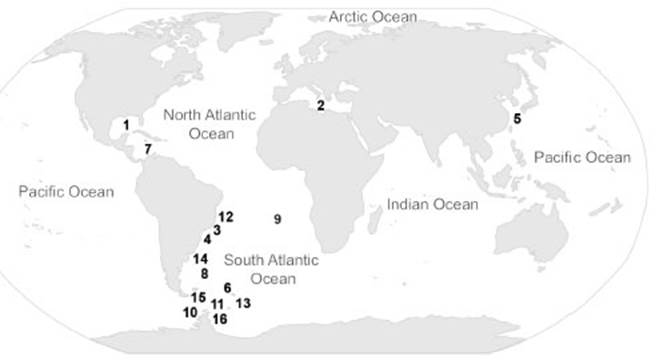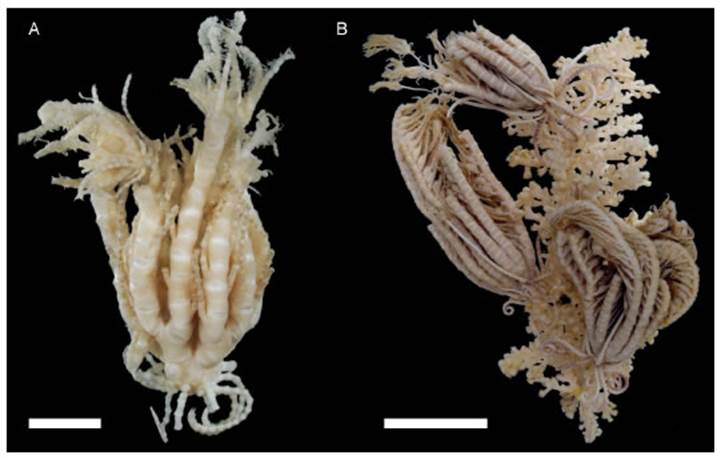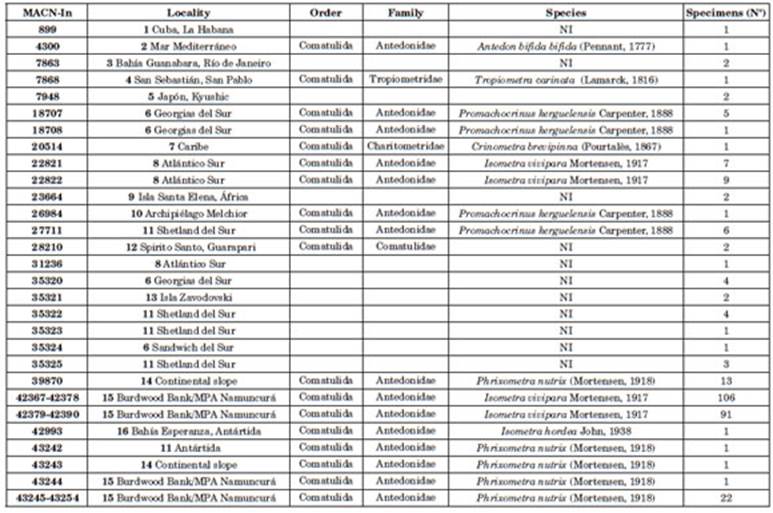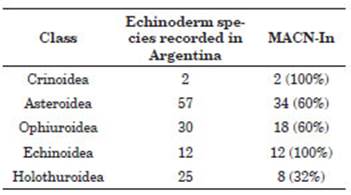INTRODUCTION
The Museo Argentino de Ciencias Naturales “Bernardino Rivadavia” (MACN) is one of the most important museums of Latin America, with 23 national collections, including the MACN-In (“Colección Nacional de Invertebrados”). This collection has more than 1411 type lots, with more than ~90 type specimens of echinoderms (Tablado & Venerus, 2000; Tablado & Mantinián, 2004; Miquel et al., 2007). Biodiversity research of echinoderms from South America increased in the last years (Alvarado & Solís-Marín, 2013). Particularly, for the Argentine Sea, several re searchers have been studying their reproduc tive, ecological, biogeographical, taxonomical, and physiological aspects (Brogger et al., 2013; Martinez et al., 2015; Pertossi et al., 2019). Echinoderms in Argentina are represented by 126 species, where Asteroidea and Ophiuroidea are the most representative groups (Brogger et al., 2013).
The Class Crinoidea is one of the five cur rent classes in the phylum Echinodermata with ~670 living species, distributed in all oceans (WoRMS Editorial Board, accessed 26 July 2021). The most diverse group within this class is Comatulida, commonly called “feather stars” or “unstalked crinoids”. It is represent ed by approximately 140 genera and ~500 spe cies. Nevertheless, unstalked crinoids are not ontogenetically accurate because the adult of comatulids retains the proximal portion of the juvenile stalk (Hyman, 1955; Hendler et al., 1995; Messing, 1997), i.e., a large modified cen trodorsal ossicle that represents a reduced stalk (Hendler et al., 1995; Cohen et al., 2004; Pawson, 2007). In Argentina, the research on crinoids is very scarce. Andersson (1904), Mortensen (1917, 1918, 1920), John (1938), Clark and Clark (1967) and, Speel and Dearborn (1983) began studying the reproduction and taxonomy of Isometra vi vipara Mortensen, 1917 and Phrixometra nutrix (Mortensen, 1918), whereas Tommasi described I. vivipara with specimens from Brazil (Tommasi 1969, Tommasi et al., 1988d). But, in Argentina, Bernasconi was the first researcher to study echinoderms (Bernasconi 1932, 1934), including the Antarctic species Promachocrinus kerguelen sis. Pertossi et al. (2019) studied the reproduc tion and developmental stages of the crinoid I. vivipara. There are only two species of comatu lid crinoids recorded in Argentina: Isometra vi vipara and Phrixometra nutrix, included in the Family Antedonidea (Brogger et al., 2013). The knowledge on taxonomy, biology, and ecology of crinoids in South America is limited (Tommasi, 1969; Bohn, 2009; Martínez et al., 2018; Martinez, 2013; Ventura et al., 2013; Catalán et al., 2020), probably due to the lack of researchers working on this group. Furthermore, consider ing that crinoids are deep-sea animals, the access to the samples is not always easy and has higher costs than studying coastal or shallow water spe cies (Eleáume et al., 2014, Ventura et al., 2013).
The present contribution aims to pro vide a complete inventory of the specimens of the Class Crinoidea deposited at the National Invertebrates collection of the Museo Argentino de Ciencias Naturales “Bernardino Rivadavia” (MACN-In). The specimens of echinoderms present in Argentina according to Brogger et al. (2013) were compared with the latestdatabase of MACN-In. Moreover, we examined and updated their identifications and records.
MATERIAL AND METHODS
We studied 56 lots of crinoids from the MACN-In. Observations were carried out under a stereoscopic microscope; images were taken with a Stereo Discovery.V20 and an Axiocam HRc digital camera. All diagnostic characters were analyzed in detail i.e., the cirri, basal, ra dial and axillary ossicles (IBr1-IBr2) oral pin nules (P1-P2-P3), genital pinnules (Pg), and arm number. We analyzed all the information of each specimen from the collection database (Pennant, 1777; Lamarck, 1816; Pourtalès, 1868; Carpenter, 1888; Bernasconi 1932, 1934; John, 1938; Clark & Clark, 1967; Mortensen, 1917; Mortensen, 1918; WoRMS Editorial Board, accessed 26 July 2021)). The location of each specimen was rep resented on a map (Fig. 1). Complementarily, we provided images of the two crinoid species recorded in Argentina, Isometra vivipara and Phrixometra nutrix (Fig. 2) and very well repre sented in this collection. All this data from the MACN-In specimens was compared with those described in near water areas, including Chile, Brazil, Uruguay and Antarctica. Finally, we com pared the specimens of echinoderms present in Argentina according to Brogger et al. (2013) with the latest database of the MACN-In.

Fig. 1 Map showing the distribution of the specimens. The numeration indicates the locality of MACN-In from Table 1.
RESULTS
The 56 studied lots of crinoids deposited at the MACN-In were composed of 286 specimens from 7 species belonging to 6 genera and 4 families: Antedonidae, Charitometridae, Comatulidae, and Tropiometridae, all of them belonging to the order Comatulida. For all the identified speci mens we observed and provided below the diag nostic characters to corroborate their identifica tion. The specimens studied here came from dif ferent locations, including Argentina, Antarctica, Brazil, Cuba, Japan, and the Mediterranean Sea (Fig. 1). Although several specimens were iden tified, 23 remained unidentified, mainly due to their poor state of preservation. They were dam aged and parts were missing (i.e., cirri, arms, and centrodorsal ossicles), which made it impossible to observe diagnostic characters. The two species described for Argentina, Isometra vivipara, and Phrixometra nutrix (Fig. 2), are well represent ed in the collection with 256 specimens (Table 1). In addition, 74 of the 126 species of echino derm present in Argentina are registered in the MACN-In collection, being the classes Crinoidea and Echinoidea the most represented (Table 2).
Crinoids from the MACN-In
Antedon bifida bifida (Pennant, 1777)
Studied material. MACN-In 4300, 1 specimen, 1898, label: ‘‘Mar Mediterráneo’’ (Mediterranean Sea). It was acquired by the MACN through a 103
purchase from Est. Zool. Naples.
Diagnosis (amended from Clark & Clark, 1967): P2 is the same length as P3 and resembles it, though it does not bear a gonad; P1 is composed of more than 25 segments; there are no more than 18 cirrus segments of which the outer ones are moderately compressed laterally, the cirri rarely exceed 40 in number; the IBr1 are very short, especially in larger specimens, and the slightly converging lateral edges form distinct angles with the projecting lateral corners of the axillaries.
Remarks. We updated the name of the lot MACN-In 4300 that included specimens of the species Antedon rosacea (Pennat, 1777), sub sequently identified as Antedon bifida bifida (Pennant, 1777). These specimens have a dis tribution from the Shetland and South Orkney Islands to northern Spain and most of Portugal (Clark & Clark, 1967), which also agrees with the distribution of the lot.
Tropiometra carinata (Lamarck, 1816)
Studied material. MACN-In 7868, 1 specimen, label: ‘‘San Pablo, Brasil’’ (San Pablo, Brazil).
Diagnosis (amended from Lamarck, 1816): 10 pinnate rays and 20 claws or dorsal cirri.
Remarks. In the case of Tropiometra carinata little is known of its patterns of distribution. Although Lamarck (1816) reported this species in France, other authors such as Tommasi (1965) and MarcCood & Duarte (2002) found T. carinata on the Brazilian coast. Besides, it was registered at Andaman and Nicobar Islands in the Indian Sea (Nigam & Raghunathan, 2015). According to the diagnosis of this species, the characters agree with the accessioned sample (MACN-In 7868).
Promachocrinus kerguelensis (Carpenter, 1888)
Studied material. MACN-In 18707, 1 spec imen, 23 m; MACN-18708, 6 specimens, 27 m, 1929, label: ‘‘Islas Georgias del Sur’’, (South Georgia Islands); MACN-In 26984, 1 specimen, 1965, label: ‘‘Archipiélago Melchior’’ (Melchior Archipelago); MACN-In 27711, 6 specimens, 80 m, 1973 label: ‘‘Islas Georgias del Sur’’, (South Georgia Islands).
Diagnosis (amended from Carpenter, 1888): P1 and P2 are similar, 20 mm in length. The first brachial ossicle is scarcely incised by the second. First radial ossicles barely visible; second ossi cles short, nearly oblong, and but slightly joined laterally. Centrodorsal plate conical and thickly covered almost to the apex with 80 or more cir ri that may reach 40 mm in length, and consist of 35 to 40 joints, which are mostly longer than wide. The later joints may slightly overlap, but the penultimate is small, with little or no trace of an opposing incised spine.
Remarks. Lots MACN-In 18707 and MACN-In 18708 were identified and studied by Irene Bernasconi (Bernasconi 1932, 1934). As far as we know, it is the only reference of a paper and she was the only one who identified these crinoid specimens at MACN.
Crinometra brevipinna (Pourtalès, 1868)
Studied material. MACN-In 20514, 1 speci men, 1932, label: ‘‘Mar Caribe’’ (Caribbean Sea).
Diagnosis (amended from Pourtalès, 1868: 111): P1 longest, with about 12 joints. The oth er pinnules are very short, having only 5 or 6 joints in the middle of the arm, the last ones be ing tipped with a hook-like cirri. Ten arms with joints slightly imbricate. Approximately 15 cirri, with the same number of long articulations. The two radials are visible and have a smooth tuber cle in the middle, as well as the axial and the two first brachials.
Remarks. Crinometra brevipinna (Pourtalès, 1868) is distributed from northern and eastern Gulf of México; coasts of Cuba to Barbados and Grenada, including Jamaica; Caribbean coast of central and South America and southward to the coast of Rio Grande do Sul, Brazil (Meyer et al., 1978). This agrees with the distribution of the lot MACN-In 20514 previously identified as C. brevi pinna, which was correctly labeled and checked here.
Isometra viviparaMortensen, 1917
Studied material. MACN-In 22821: 54°50′S- 64°01′W, 1 specimen, 151 m, 1935. MACN-In 22822: 54°57′S-64°42′W, 12 specimens, 265 m, 1935, labels: ‘‘Atlántico Sur’’ (South Atlantic). MACN-In 42367: 54°25′S-58°31′W, 27 specimens, 137 m. MACN-In 42368: 54°51′S-60°0′W, 25 spec imens, 159 m. MACN-In 42369: 54°32′S-60°1.2′W, 3 specimens, 98 m depth. MACN-In 42370: 54°10′S-58°16′W, 2 specimens, 100 m. MACN-In 42371: 54°11′S-58°19′W, 1 specimen, 95 m. MACN-In 42372: 54°30′S-59°52′W, 8 specimens, 109 m. MACN-In 42373: 54°37′S-61°9′W, 4 speci mens, 202 m. MACN-In 42374: 54°28′S-59°13′W, 4 specimens, 128 m. MACN-In 42375: 54°32′S-61°26′W, 20 specimens, 125 m. MACN-In 42376: 54°35′S-58°38′W, 1 specimen, 140 m. MACN-In 42377: 54°36′S-62°51′W, 3 specimens, 608 m. MACN-In 42378: 54°24′S-58°28′W, 8 specimens, 95 m, 2016, labels: ‘‘Area Marina Protegida Namuncurá/Banco Burdwood’’ (Burdwood Bank/MPA Namuncurá). MACN-In 42379: 55°6′S-65°44′W, 9 specimens, 263 m. MACN-In 42380: 54°52′S-64°16′W, 36 speci mens, 151 m. MACN-In 42381: 54°39′S-63°49′W, 2 specimens, 143 m. MACN-In 42382: 54°24′S-62°49′W, 4 specimens, 483 m. MACN-In 42383: 54°26′S-58°32′W, 13 specimens, 138 m. MACN-In 42384: 54°26′S-59°30′W, 6 specimens, 91 m. MACN-In 42385: 53°40′S-61°38′W, 3 speci mens, 642 m. MACN-In 42386: 53°34′S-63°58′W, 2 specimens, 263 m. MACN-In 42387: 53°34′S-62°58′W, 2 specimens, 516 m. MACN-In 42388: 53°49′S-61°28′W, 4 specimens, 209 m. MACN-In 42389: 53°49′S-61°19′W, 8 specimens, 197 m. MACN-In 42390: 54°39′S-63°49′W, 2 spec imens, 143 m, 2017, labels: Burdwood Bank/MPA Namuncurá.
Diagnosis (amended from Clark & Clark, 1967): P1 is up to 10. 5 mm long with 10 to 17 segments, whereas P2 is usually 1.5 to 2.0 mm shorter with 9 to 14 segments and no longer than 8.5 mm.; P5 is usually the first genital pinnule, with 26-43 cirri, the longest segments hardly, if ever, longer than wide.
Remarks. The specimens MACN-In 28821 and MACN-In 28822 were studied by Bernasconi who largely contributed to subsequent studies. Also, Pertossi et al. (2019) studied the reproduc tion and developmental stages in the crinoid I. vivipara.
Phrixometra nutrix (Mortensen, 1918)
Studied material. MACN-In 39870: 38°51′S- 55°35′W, 5 specimens, 145 m, 2009, MACN-In 43242: 38°51′S′′S-55°34.58′W, 1 specimen, 140 m, 2009, MACN-In 43243: 38°51′S-55°34′W 7 specimens, 140 m, 2009, labels: ‘‘Talud conti nental’’ (Continental slope). MACN-In 43244: 61°49.6′S-57°34.4′W, 1 specimen, 210 m, 2011, label: ‘‘Antártida’’ (Antarctica). MACN-In 43245: 37°57.9′S-55°12.73′W, 1 specimen, 201 m, 2012, label: ‘‘Talud continental’’ (Continental slope). MACN-In 43246: 54°27′S-60°58′W, 1 specimen, 100 m, 2016, label: Burdwood Bank/MPA Namuncurá. MACN-In 43247: 53°49′S-61°28′W, 1 specimen, 209 m. MACN-In 43248: 54°36′S-61°30′W, 2 specimens, 294 m. MACN-In 43249: 54°51′S-63°52′W, 2 specimens, 330 m. MACN-In 43250: 55°5.5′S-60°41.9′W, 5 specimens, 122 m. MACN-In 43251: 54°48.79′S-63°45.91′W, 1 specimen, 278 m. MACN-In 43252: 59°26′S-59°30′W, 7 specimens, 91 m. MACN-In 43253: 54°5.2′S-60°53′W, 3 speci mens, 132 m. MACN-In 43254: 53°31′S-63°1.8′W, 1 specimen, 512 m, 2017, labels: Burdwood Bank/ MPA Namuncurá.
Diagnosis (amended from Clark & Clark, 1967): P1 has approximately 14 segments; P2 is usual ly the first genital pinnule and similar in length and number of segments to P1; the cirri of these crinoids are approximately 45, with less than 20 segments.
Remarks. P. nutrix is distributed in South America, from the Magallanes Region, in the Pacific Ocean, to the Namuncurá / Burdwood Bank Marine Protected Area, in the Atlantic Ocean, and Antarctica, from the Antarctic Peninsula and some Subantarctic Islands (Spell 105
& Dearborn, 1983). We incresed their distribution near the Mar del Plata Submarine Canyon area (38°51’S-55°35’W, MACN-38970). Additionally, we updated the bathymetric range from 150 to 200m (Clark & Clark, 1967) to 512 m (Pertossi et al., 2021).
Isometra hordeaJohn, 1938
Studied material. MACN-42993: 63°23′S- 57°00′W, 1 specimen, 260 m depth. Collected in ‘’Bahía Esperanza, Antártida’’ (Hope Bay, Antarctica).
Diagnosis (amended from Clark & Clark, 1967): the cirri are 40-62 with 25-75 segments; the first two pinnules are relatively small, especially P1, which does not exceed 5mm in length; the first genital pinnule is usually P5; in the female, the third to seventh segments of the genital pinnules are usually expanded; this is a very large species with a length reaching up to 17 mm from the proximal edge of the IBr1 to the second syzygy at 9+10.
Remarks. We identified the specimen MACN-In 42993 as Isometra hordeaJohn, 1938. The distribution of I. hordea is South Africa, South Shetlands, South Orkneys, and off Cape Adare in the Ross Sea. Here we report it in Hope Bay at 260m. All the characteristics observed resemble this species, like pinnule in position 2 (P2) being longer than P1, the number of the cirri between 25-75, and up to 70 segments, the first genital pinnule is usually P5 (John, 1938; Clark & Clark, 1967; Spell & Dearbon, 1983) (Table 1)
DISCUSSION AND CONCLUSION
Echinoderms are well represented along the Argentine coast with more than 126 living species described, represented by 58 species of asteroids, 30 ophiuroids, 25 holothuroids, 12 echinoids, and 2 crinoids (Brogger et al., 2013; O´Loughlin et al., 2011; Martinez et al., 2015). According to this, representatives of the only two known species of Crinoidea recorded in Argentina are deposited at MACN-In. By con trast, only 60% of the Asteroidea species re corded from Argentina are represented in the MACN-In, as well as, 65% of Ophiuroidea, 100% of Echinoidea, and 32% of Holothuroidea. Of the 56 lots of the studied crinoids, 70% of the speci mens are from the Southwestern Atlantic Ocean and the Antarctica, while the others proceed from the Caribbean area, Mediterranean Sea, and Japan.
In Chile, Uruguay, and Brazil, the research of crinoids is limited. In Chile, the crinoid diver sity is composed of five species of comatulids:
Florometra magellanica (Bell, 1882), Isometra vivipara, Phrixometra nutrix, Promachocrinus kerguelensis, and Solanometra antarctica (Carpenter, 1888) (Bohn, 2009; Catalán et al., 2020). The eastern South Pacific Ocean shares two crinoids with the southwestern Atlantic Ocean, I. vivipara and P. nutrix. In the present contribution, no species of Crinoidea were regis tered of the 37 species of echinoiderms reported from Uruguay (Martinez, 2013). According to Martinez (2013), there has been no systematic sampling of the Uruguayan waters, therefore the proportion among classes might not be re liable. Moreover, considering that research-ori ented faunistic surveys have been scarce, except for recent years, and that the diversity of species in the collections has not been studied, it can be said that the number of species is not very clear (Martinez, 2013). In Brazilian waters, 16 cri noids species have been reported (Ventura et al., 2013). Among them, specimens of Tropiometra carinata could be found deposited at the MACN-In collection under the number #7868 (Table 1). MacCord & Duarte (2002), described the disper sion pattern and size structure of the crinoid T. carinata along the southeastern Brazilian coast (MacCord & Duarte, 2002; Ventura et al., 2013). Of the 44 crinoid species recorded in Antarctica (Eléaume et al., 2014), the MACN-In collection houses specimens of only 4 species: Isometra hordea, Isometra vivipara, Phrixometra nutrix, and Promachocrinus kerguelensis.
In Argentina, research on the Phylum Echinodermata has been increasing in the last years (Brogger et al., 2013; Martinez et al., 2015), but crinoids are still one of the most enigmat ic groups in the region. This inventory provides updated information on the Crinoidea collection deposited at the Museo Argentino de Ciencias Naturales “Bernardino Rivadavia”, Buenos Aires, Argentina, and constitutes a valuable tool for fu ture studies dealing with echinoderms and, par ticularly, those pertaining to the Class Crinoidea












 uBio
uBio 




